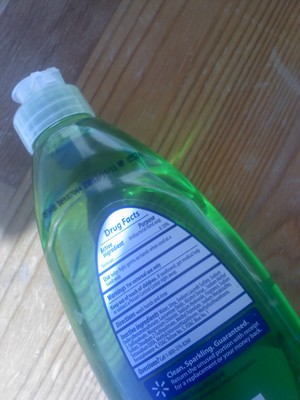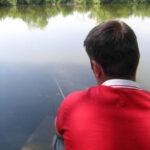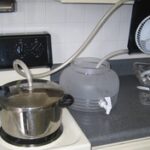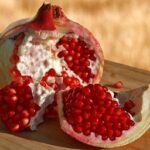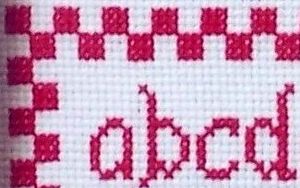I have gone through phases where I make my own dish washing soap. It takes little more than a box of soap flakes, water and some glycerin oil, but occasionally, I’ll find myself in the grocery store and lured by the pretty colors and wonderful scents, I’ll break down and buy a bottle of the commercial stuff. Like many other folks, I grew up using the familiar brands and never thought much about what went into making commercial dish soap, after all, some common brands are famously used to bathe pets or rescued wildlife. I have used dish soap on my own dogs and in a pinch and added it to water that I used to wash floors, cars, counter tops and have even added a few drops to laundry.
But after experiencing a strange all-over body rash one day – a condition that sent me to the doctor and required antibiotics and antihistamines to overcome – someone suggested that while the cause of most rashes usually remain unknown, the chemicals in many consumer products are often the culprit. Could it be that I had suffered an allergic reaction to my commercial dish soap or bubble bath? I’ll probably never know the answer to that, as thankfully the rash disappeared soon after I began taking the prescribed antibiotics and antihistamines, but the incident did cause me to look a little more closely into some of the commercial products in my home.
I began with my dish soap, a lovely green concoction with a pleasant apple aroma. Certainly something so pleasing to the senses couldn’t be so bad: could it? I put on my glasses and read the ingredients: active ingredient, triclosan, 10 percent; water, urea, sodium laureth sulfate, sodium dodecylbenzenesulfonate, lauramine oxide, alcohol denat, sodium methyl, 2sulfopalmate, magesium chloride, sodium hydroxide, fragrance, sodium sulfate, disodium 2-sulfopalmate, methyl palmitate, sodium metabisulfate, tetrasodium EDTA, methylcloriosothiazodinone, methylisothiazolione, benzaphenone, colorings.
While all of the ingredients in the soap are believed safe and are approved by federal officials for use in dish soap (as well as other consumer products), I began to wonder exactly what these ingredients were and why something as simple as dish soap, which normally requires little more than soap flakes, needed so many chemicals to clean a dish. After all, the skin is a porous organ. It absorbs things in comes in contact with, whether it be chemical-laced shampoo, body lotion or dish soap. That in mind, shouldn’t we at least be educated about what these products contain?
Triclosan. A common anti-bacterial agent, triclosan is found a variety of consumer products – everything from my antibacterial dish soap to shampoo and toothpaste and even clothing. Triclosan has been used in consumer products for more than 30 years, but whereas the chemical was only in a couple of dozen of products in the 1990s, it is now found in nearly 1,000 products. The Centers for Disease Control and Prevention says that small amounts of the chemical can be absorbed by a person’s skin. Although it is not used in any food products, one study found that nearly 75 percent of people tested positive for triclosan in their urine, according to the CDC. The agency said that low-level effects are not known. “Skin products containing triclosan rarely have caused irritation. More research is needed to assess the human health effects of exposure to triclosan,” the CDC reports. While it is considered safe for humans in rinse off applications, like soaps and shampoos, “many studies have uncovered scientific evidence that the chemical is contributing to the surge in life-threatening, antibiotic-resistant super-germs and severe hormone disruption in wildlife. (When it’s found in waterways, for example, male frogs literally sport female parts.),” reports Rodale.com. Another common complaint is that triclosan contributes to a surge in mutated, harder-to-kill bacteria.
Water. Water is water. I did not do any research on this one, just assumed that the water was safely filtered.
Urea. Synthesized from ammonia, urea is used as a stabilizer in many of the consumer products we buy, especially hair conditioners, skin lotions, dish soaps and cigarettes. In small amounts, it is not considered harmful. In larger amounts, urea is used to make glue, to waterproof certain building materials and even as an ingredient in fertilizer, among other things.
Sodium laureth sulfate (also known as sodium lauryl ether sulfate). A surfactant derived from petroleum, sodium laureth sulfate, is a foaming agent that is mainly used to produce suds. Most believe that the when SLS is used properly, it is not harmful. The Personal Care Products Council (formerly the Cosmetic, Toiletry and Fragrance Council) on its Web site says: “There is no evidence of harm from the use of either SLS or SLES as used in cosmetic products. Both ingredients were reviewed in 1983 by the Cosmetic Ingredient Review (CIR) Expert Panel and found to be safe.” Not everyone agrees. A simple Internet search for “sodium laureth sulfate” brought up several sites touting the ingredient as a cancer-causing or as something that can cause skin rashes and other serious problems. The Personal Care Products Council says that rumors about SLS causing cancer have been debunked. SLS is found in some industrial cleaners, but shampoos, dish detergents and other common household products contain lesser concentrations of the ingredient.
Sodium dodecylbenzenesulfonate. An ingredient also found in pesticides, sodium dodecylbenzenesulfonate is surfactant that in dish detergent detergent, is used as both a wetting agent or foaming agent. Sodium dodecylbenzensulfonate’s job in dish soap is to stabilize the water and oil and keep them from separating once mixed. Because the surfactant’s molecule attaches itself to water, grease and dirt, it is especially useful in dish washing detergent as it loosens dirt for easier cleaning, according to the P&G; Web site, www.scienceinthebox.com Web site. It is also commonly used in products that clean fruits and vegetables. While surfactants can be made from vegetable or animal materials, others are synthetic and are derived from petroleum, according to P&G.; Like it’s cousin, sodium laureth sulfate, sodium dodecylbenzensulfonate is derived from petroleum. The Environmental Working Group’s Skin Deep Cosmetic Safety Database says that while sodium dodecylbenzenesulfonate is approved for use in many skin care products, some animal studies have shown the ingredient can cause skin irritations at low levels.
Lauramine Oxide. Another surfactant, lauramine oxide enhances is generally added to dish detergent, shampoos, conditioners and other products to enhance foaming. Although there have been some studies that link lauramine oxide to skin irritations, it is approved by the FDA for use in “rinse off” applications. The Environmental Working Group’s Skin Deep Cosmetic Safety Database reports that lauramine oxide has caused some skin irritations in animal studies.
Alcohol denat. A type of ethanol, in dish detergent, alcohol denat is usually added as an antimicrobial agent. But it shows up in many personal care products including lotions, acne medicine and hair gel among other things.
Sodium Methyl 2-sulfopalmate. A tongue-twister, this ingredient is another surfactant added to enhance cleansing and foaming.
Magnesium chloride. A salt-based cleansing enhancer, magnesium chloride can be harmful to humans if inhaled or swallowed in large amounts. Magnesium chloride shows up in lots of products and is well-known as a de-icing agent. But it is corrosive to metal in large amounts and many say it is also harmful to the environment, impacting fish and wildlife when it reaches waterways.
Sodium hydroxide. Also known as lye and caustic soda, sodium hydroxide is a manufactured chemical common in cleaning products. Although dish soaps contain only trace amounts, in slightly larger quantities, sodium hydroxide can cause skin and eye irritations.
Fragrance. Generally, dish soap fragrances are synthetic and chemically-based, but there are some natural ones out there. It is added to give the soap an appealing scent.
Sodium sulfate. A natural salt, sodium sulfate is also used to create soda ash. It is considered non-toxic.
Disodium 2-sulfopalmate. Another type of surfactant, this ingredient is designed to enhance cleaning power.
Methyl palmitate. A chemical added for fragrance.
Sodium Metabisulfite. An inorganic chemical compound, this ingredient is a cleaning agent.
Tetrasodium EDTA. A poly-amino acid, this ingredient generally serves to soften the water.
Methylcloriosothianzdinone. I could not find much on this.
Methylisothiazolione. An organic compound.
Benzophenone. An organic compound that helps to preserve the color and scent of the soap. Known for its ability to block ultra-violet rays, it is an ingredient that is commonly used in sunscreen. In humans, it is believed to be a possible human photo-allergenic toxin, according to the Environmental Working Group, and some human case studies have shown significant photo-allergenic effects. It is also believed to be toxic to animals and wildlife.
While there are some wonderful all-natural dish soaps on the market, I’ll go back to using the tried-and-true homemade versions. Soap flakes, by the way, are made from vegetable oils and are all-natural and chemical-free. In the end, the homemade version works just as well as the commercial stuff, is much cheaper and is yet another way to reduce consumerism while avoiding exposure to chemicals.
Aside from the health and economic benefits of making your own all-natural dish soap, consider this: when you are finished washing your dishes, where does the water go? Unless you are religious about reusing the soapy water (to clean your toilets or water your plants, for example) chances are you release it right back down the drain, where once it is reclaimed and recharged by the sewer system, it is most likely released into the ground (when watering golf courses or irrigating farm fields) or in some cases, back into surface waterways along with trace amounts of those petro-chemicals you used to wash your dishes.
Sources:
1. Bottle of Great Value dish washing soap, ingredient list.
1. Centers for Disease Control and Prevention Web site, Triclosan Fact Sheet, viewed March 15, 2010, http://www.cdc.gov/exposurereport/Triclosan_FactSheet.html
2. Rodale.com, March 15, 2010 http://www.rodale.com/triclosan-dangers
3. Environmental Working Group, www.ewg.org viewed March 15, http://www.cosmeticsdatabase.com/ingredient.php?ingred06=706062
4. Cosmetic, Toiletry, and Fragrance Association (CTFA) Web site, viewed March 15, www.personalcarecouncil.org
5. P&G; Web site, accessed March 15, http://www.scienceinthebox.com/en_UK/glossary/surfactants_en.html
